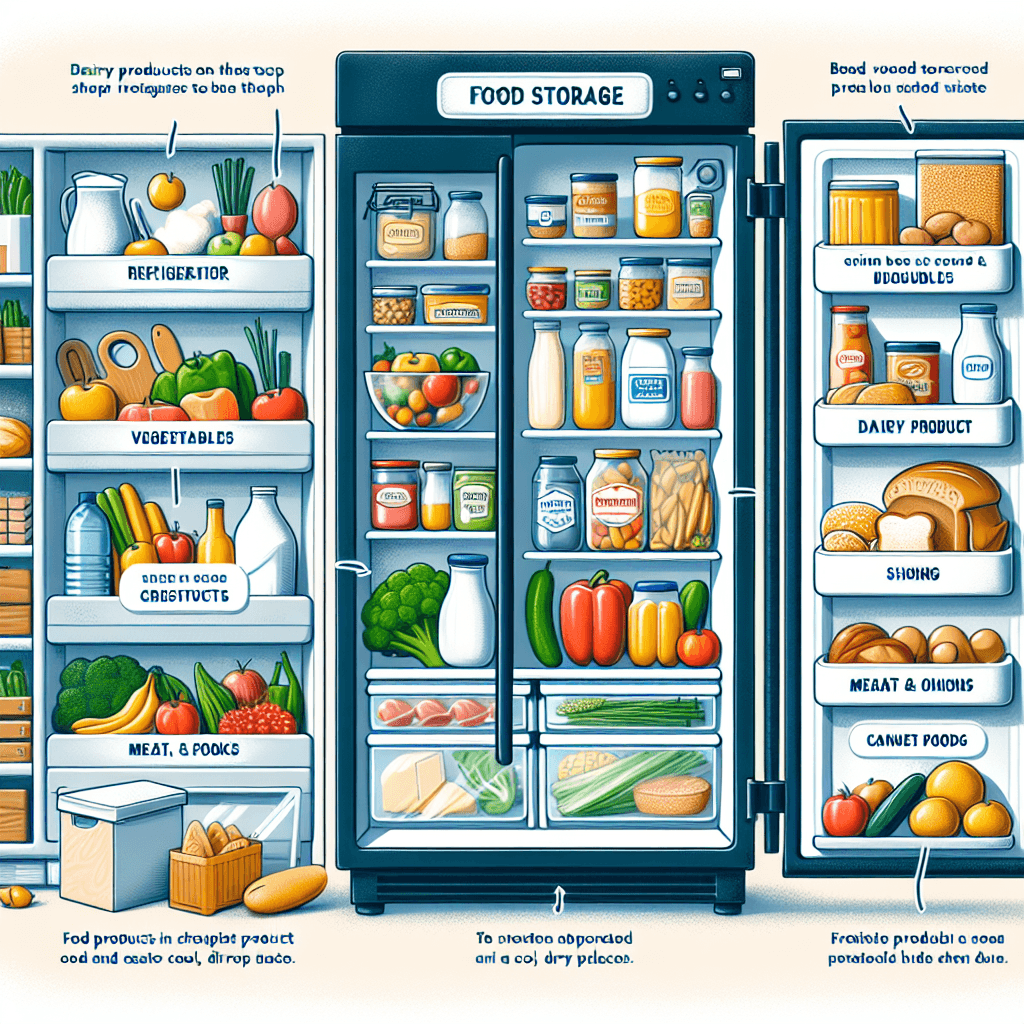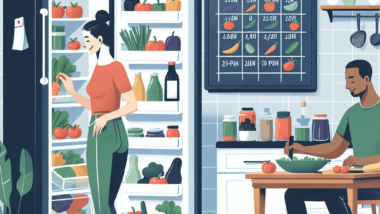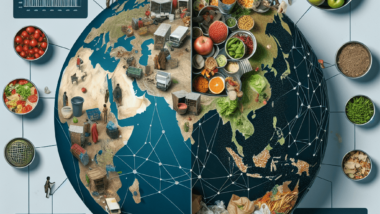Tips for Efficiently Storing Food to Reduce Waste
Did you know that food waste contributes to significant economic losses and environmental harm? By implementing effective food storage practices, you can make a meaningful difference in both your wallet and the planet. Here are the key takeaways from our guide on minimizing food waste and promoting sustainability in your kitchen.
What You Will Learn
- The environmental and economic impacts of food waste, including greenhouse gas emissions and resource wastage.
- How proper food storage techniques can prevent spoilage and reduce foodborne illnesses.
- Effective fridge organization tips to help you easily identify and use items before they spoil.
- The importance of using airtight containers and proper labeling to maintain food freshness and minimize waste.
- Key freezing techniques to extend the shelf life of food and prevent spoilage.
- Best practices for storing fruits, vegetables, grains, and canned goods to enhance their longevity.
- How to implement the FIFO (First In, First Out) method to manage your pantry inventory effectively.
- The significance of meal planning and creative uses for leftovers to reduce food waste.
- Steps to engage your family in minimizing food waste and tracking progress over time.
- Ideas for hosting community workshops to promote food storage knowledge and waste reduction efforts.
Empowering Women: Best Food Storage Practices to Minimize Waste
Understanding the Impact of Food Waste on Our Lives
Exploring the Environmental and Economic Effects of Food Waste
Food waste is a pressing issue that affects not only our environment but also our economy. When food is wasted, it contributes to greenhouse gas emissions, which harm our planet. Additionally, wasting food means wasting the resources used to produce, transport, and store that food, leading to significant economic losses for households and communities.
Some of the key environmental impacts of food waste include:
- Increased landfill overflow
- Higher carbon emissions from decomposing food
- Wasted water used in food production
Why Proper Food Storage is Essential for Sustainability
Storing food correctly can dramatically reduce waste and support a more sustainable lifestyle. By ensuring that our food stays fresh longer, we not only save money but also lessen our environmental footprint. Implementing proper food storage practices is a simple yet effective way to contribute to sustainability efforts.
Here are some reasons why proper food storage matters:
- Prevents spoilage and foodborne illnesses
- Maximizes the use of food resources
- Encourages mindful consumption habits
Organizing Your Kitchen: The First Step to Reducing Food Waste
Creating a Functional and Efficient Fridge Organization System
An organized kitchen is key to minimizing food waste. By creating a system that works for you, it becomes easier to see what you have and what needs to be used first. A well-structured fridge not only keeps your food fresh but also helps you make informed decisions about meal preparation.
Consider these tips for better fridge organization:
- Store perishables at eye level
- Group similar items together
- Use clear containers for easy visibility
Utilizing Crisper Drawers for Maximum Freshness
Crisper drawers in your fridge are designed specifically to keep fruits and vegetables fresh longer. When used correctly, these drawers can prevent wilting and spoilage. It’s essential to understand how to use them effectively to get the most out of your produce.
Here’s how to optimize your crisper drawers:
- Keep fruits and vegetables separate
- Adjust humidity settings based on food type
- Check and remove spoiled items regularly
Maximizing Shelf Life: The Importance of Airtight Containers
Choosing the Right Containers for Different Food Types
Using the right containers can significantly impact the shelf life of your food. Airtight containers are essential for preserving the freshness of dry goods, leftovers, and even some produce. Selecting the correct type of container helps minimize exposure to air and moisture, which can lead to spoilage.
Consider these container types:
- Glass jars for grains and legumes
- Plastic containers for leftovers
- Vacuum-sealed bags for long-term storage
Labeling and Dating: Best Practices for Food Management
Labeling your food items is a smart way to keep track of what you have in your kitchen. By marking the date of purchase or preparation, you can ensure that older items are used first, helping to reduce waste. This practice also helps you stay organized and aware of what needs to be consumed soon.
Here are some labeling tips to follow:
- Use waterproof markers for durability
- Include both the date and contents on labels
- Regularly check and update your inventory
Harnessing the Power of Your Freezer for Longer Food Preservation
Essential Freezing Techniques to Prevent Spoilage
The freezer is a fantastic tool for extending the life of your food. When used correctly, it can keep food fresh for weeks or even months, preventing spoilage and waste. Understanding the best freezing techniques will help maximize the benefits of your freezer.
Some key freezing techniques include:
- Flash freezing fruits and veggies before storage
- Using airtight packaging to prevent freezer burn
- Organizing your freezer for easy access
Foods That Freeze Well: A Guide to Freezing Your Groceries
Not all foods freeze equally well, so it’s essential to know which items are best suited for freezing. Keeping track of what you can freeze helps you take advantage of sales and meal prep, ultimately reducing waste. Here’s a list of foods that typically freeze well:
- Fruits like berries and bananas
- Vegetables such as broccoli and carrots
- Cooked grains and pasta
- Meats and poultry
Tailoring Storage Methods to Different Food Categories
The Best Practices for Storing Fruits and Vegetables
Each type of produce has unique storage needs. Understanding how to store fruits and vegetables properly can make a big difference in their longevity. Here are some best practices for keeping your fruits and vegetables fresh:
- Store apples away from other fruits to prevent spoilage
- Keep leafy greens wrapped in a damp cloth
- Use breathable bags for potatoes and onions
Understanding the Unique Storage Needs of Grains and Canned Goods
Grains and canned goods also require specific storage methods to maintain their quality. Storing them correctly can prolong their shelf life and reduce waste. Here’s how to store these items effectively:
- Keep grains in airtight containers in a cool, dry place
- Store canned goods in a dark, cool cabinet
- Check for expiration dates regularly to rotate stock
Implementing the FIFO Method: Rotating Your Pantry Items
The Importance of Inventory Management in Food Storage
Implementing the FIFO (First In, First Out) method is a great way to manage your pantry inventory. By using older items before newer ones, you ensure that nothing goes to waste. This system can be easily applied in both the fridge and pantry.
Follow these steps to implement FIFO:
- Place newer items behind older ones
- Regularly check for expired items
- Use a list to track what you have
Tips for Keeping Track of Expiration Dates
Keeping track of expiration dates is crucial for minimizing waste. By knowing when items expire, you can plan meals accordingly and avoid wasting food. Here are some effective tips:
- Use a calendar or app to track expiration dates
- Regularly check your pantry and fridge
- Be mindful of how long items have been stored

The Role of Meal Planning in Reducing Food Waste
How to Create an Effective Meal Plan That Works for You
Meal planning is one of the best ways to ensure you’re using your food wisely. By planning your meals ahead of time, you can make the most of what you have and reduce unnecessary purchases. A well-structured meal plan can help you stay organized and save money.
Consider these steps for effective meal planning:
- Choose meals that use similar ingredients
- Plan for leftovers to minimize waste
- Prepare a shopping list before going to the store
Making the Most of Leftovers: Creative Uses and Recipes
Leftovers can be a great way to reduce food waste and save time. Instead of letting them go to waste, think of creative ways to use them in new meals. Here are some ideas for making the most of your leftovers:
- Turn leftover vegetables into stir-fries
- Add leftover meats to salads or wraps
- Make soups or casseroles with various leftovers.
Taking Action: Steps Toward a Waste-Free Kitchen
Incorporating Sustainable Practices into Your Daily Routine
Engaging Your Family in Minimizing Food Waste
Getting your family involved is key to reducing food waste. Start by having discussions about why it’s important to save food. Make it a fun challenge by tracking who can come up with the best ideas for using leftovers!
- Set up weekly family meetings to share ideas.
- Create a food waste tracker together.
- Involve kids in meal planning to boost their interest.
Tracking Your Progress: Measuring the Impact of Your Efforts
It’s important to see how much progress you’re making in your waste-free journey. Tracking your food waste can help you spot patterns and areas for improvement. Use a simple system to keep an eye on what’s being wasted.
- Keep a journal of your food waste each week.
- Use apps designed to track food expenses and waste.
- Compare monthly progress for motivation.
Empowering Communities: Sharing Knowledge on Food Storage and Waste Reduction
How to Host Workshops and Events Around Sustainable Practices
Hosting workshops is a great way to spread the word about reducing food waste. Gather your friends, neighbors, or community members to learn together! You can create a fun and informative event that inspires others.
- Offer hands-on demonstrations on proper food storage.
- Share recipes that utilize leftovers.
- Encourage group discussions and share tips.
Collaborating with Local Organizations to Promote Food Security
Partnering with local organizations can amplify your efforts in reducing food waste. Work with food banks, schools, or farmers’ markets to share knowledge and resources. Together, we can make a bigger impact!
- Organize community food drives.
- Host educational sessions at local events.
- Create pamphlets to distribute at farmers’ markets.
As you read this you may also like the following articles on this topic:
Final Thoughts on Sustainable Food Storage Practices
Embracing Mindfulness in Your Kitchen to Combat Food Waste
Mindfulness in the kitchen means being aware of our food choices and how we store them. This helps us make better decisions that lead to less waste. Take a moment to think about the journey your food takes before it reaches your plate.
- Practice mindful shopping by making a list before heading out.
- Reflect on portion sizes to avoid cooking too much.
- Think creatively about using all parts of the food (like veggie scraps).
Call to Action: Start Your Journey Towards a Greener Lifestyle Today
It’s time to take the first step toward a waste-free kitchen! Start implementing these tips and encourage others to join you. Together, we can create a cleaner environment and a healthier planet!
- Identify one area to improve this week.
- Share your journey on social media to inspire others.
- Celebrate your successes, no matter how small!

Food waste is a significant issue that affects both the environment and our wallets. One way to combat this problem is by implementing proper food storage practices to extend the shelf life of our groceries and minimize waste. By following these best food storage practices, you can not only reduce your carbon footprint but also save money in the long run.
1. Keep Your Fridge Organized: A well-organized fridge can help you keep track of what you have and prevent items from getting lost or forgotten at the back of the shelves. Store perishable items like dairy, meat, and leftovers on the middle shelves where the temperature is most consistent. Place fruits and vegetables in the crisper drawers to maintain their freshness.
2. Use Airtight Containers: Transfer leftovers or opened packages of food into airtight containers to prolong their shelf life. This helps prevent exposure to air and moisture, which can cause food to spoil more quickly. Label containers with the date they were stored to ensure you use them before they go bad.
3. Utilize Freezer Space: Your freezer can be a valuable tool for extending the shelf life of many foods. Freeze items like bread, meat, fruits, and vegetables that you won’t be able to use before they spoil. Make sure to package them properly in freezer-safe bags or containers to prevent freezer burn.
4. Store Food Properly: Different types of foods require different storage methods to stay fresh longer. For example, potatoes should be stored in a cool, dark place away from onions, while tomatoes should be kept at room temperature until ripe and then refrigerated to slow down ripening.
5. Rotate Your Pantry Items: When stocking your pantry with canned goods and dry staples, make sure to rotate older items to the front so they get used first. This helps prevent items from expiring before you have a chance to use them.
6. Check Expiration Dates: Regularly check the expiration dates on your food items and prioritize using those that are closest to expiring. This will help you avoid having to throw away expired food that could have been consumed earlier.
7. Plan Your Meals: Meal planning can help you buy only what you need and avoid overbuying perishable items that may go bad before you can use them up. By planning your meals ahead of time, you can also make use of leftovers more efficiently.
By incorporating these best food storage practices into your routine, you can significantly reduce food waste in your household while also saving money and contributing positively to the environment. With a little effort and mindfulness, we can all do our part in minimizing waste and making more sustainable choices when it comes to storing our food.



